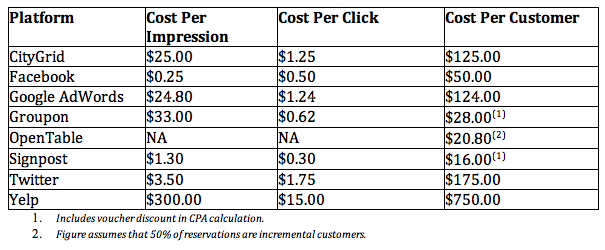
Today's small business owners are faced with a seemingly endless parade of online marketing vendors, many of which are indistinguishable at first glance. Each one promises new customers and online exposure at a lower price than the next. But at the end of the day, many of these options are nothing more than lip service, a flashy website and a sales team that's too eager to draw from your already limited marketing budget.
Let's take Yelp for example. They have a notoriously aggressive sales team that hits local businesses from all sides. Yelp is an incredibly successful business with tens of millions of users, so it seems like a no-brainer, right? Wrong. When you look closer, Yelp charges outrageous rates: anywhere from $367 to $600 per 1,000 ad impressions. That's about 1,000 times more than average.
So what's an SMB to do? How do you separate hype from reality and choose the right marketing platform? Read on to learn how you can ensure your campaigns are driving a solid return on your investment.
Choose Your Metrics Wisely
If you're like me, your eyes start to glaze over when you see too many acronyms. But understanding the three basic pricing models for online advertising -- CPM, CPC and CPA -- is absolutely essential to getting the most of your marketing dollars. So for starters, let's breakdown what each one means:
- CPM stands for cost per thousand impressions (M stands for mille, the latin word for 1,000). Under this model an advertiser pays a fixed cost for every thousand people who view the ad.
- CPC stands for cost per click, and is also called PPC or pay per click. With this model, advertisers pay the publisher or website owner every time someone clicks on their ad.
- CPA or cost per acquisition is a model that allows advertisers to pay only for the advertisement when their desired action has occurred, whether that be a purchase, a form submission, registration, etc.
Before you decide what pricing model is right for your business, you'll need to define your online marketing objectives. If you're like most small business owners, getting customers through the door is far and away your biggest marketing goal, which means that a CPM or CPC-based campaign probably doesn't make a lot of sense. These models are primarily focused on driving things like brand awareness, which matter far more to large, global brands like Pepsi or Nike. The potential audience for their products is far wider than a small local business. Even with the best possible targeting, impression or click-based campaigns often result in wasted ad dollars because they're seen by the wrong audience. Alternatively, the CPA model ensures that you're only paying when your ad results in a customer acquisition.
So why are most local businesses paying for impressions and clicks? In the past, most local businesses weren't able to accept a purchase online so tracking a CPA was impossible. Online marketers had a disincentive to estimate CPA since the purchase rate was low: most consumers forget to actually visit a local business weeks or even months after clicking on an ad for that business online.
The good news is that a growing number of online marketers are closing the loop for local businesses enabling better measurement and CPA based pricing. Leading restaurant reservation platform OpenTable is perhaps one of the best examples. OpenTable charges a restaurant owner when diners make reservations, which means a portion of their OpenTable fees are based on performance. Other great examples of online marketers that are able to close the loop include Seamless Web, LevelUp, Groupon and Signpost.
Knowing What to Spend
The cost structure of an online marketing campaign varies significantly based on the platform, making apples-to-apples comparisons challenging. This is also why it's easy to end up overpaying. We've put together a table that helps make sense of the various options and shows you what you'll pay on average to acquire a new customer through each service respectively.

As an entrepreneur, I know that running your own business is challenging and sifting through a barrage of marketing options is the last thing that any small business owner wants to do. The good news is that it only takes a little bit of research and looking at the numbers to figure out which ones are going to move the needle and which are ones aren't worth your time.